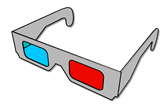

3D Stereo Anaglyph: how to
Stereo Vision: how does it work
We see in 3D because of the separation of our eyes, and a global cultural process that from birth has told us what is close and what is far, and how much far away. This skill we have achieved through a trial/error process when we were kids, and through observation while growing up.
Moreover: the average distance of the person's eyes (Interpupillary Distance - IPD goes from 52mm to 76 mm (Wikipedia reference). A little more or less makes no difference, because the brain will compensate and enhance the information it will receive.
3D Anaglyphs: pros and cons
There are several ways to achieve the 3D effect with your camera(s).
Anaglyph, red/cyan glasses is, in some way, the fastest and cheapest, but a the very imperfect method:
- can be done putting together b/w or color pictures
- red/cyan glasses are easy to find and cheap
- books, postcards, posters can be made and easily shown
... but:
- no color, or sort of fake ones
- ghosting on images with too exaggerated 3D effect.
Ghosting-free Anaglyphs?
Ghosting can be better explained as "a double image that is perceived, and not really seen" that makes the viewing kind of a strain on the couple eyes/brain.
Avoiding ghosting is almost impossible.
But what can be done is:
- reduce it as much as possible
- avoid shooting in very high contrast (no full sun!)
- use good red/cyan glasses (quality depends on wavelengths that lens can separate, paper ones can be as good as more expensive ones, but not always.
Aiming for the best results
To make the best 3D pictures (hey, I'm giving my tricks away!) we have to exaggerate the 3D information we provide to the brain, but not too much, or it won't be able to resolve the image.
Too much confusion = no 3D effect and little clarity of the image itself.
3D Slide Bracket Rig
An average 3D Slide Rig needs to have:
- 2 small cameras of the same brand, model, etc. Even better if they are of the same production batch
- a slide bracket having a minimum camera distance of more or less the width of the cameras you are using
- and a decent large enough separation (maximum distance between cameras)
In my opinion when you are working with at least 25 cm (10") you are doing OK
As for potential results, please, check out my pictures on these galleries, almost all of them have been taken with more or less these parameters, and start evaluating the possibilities ...